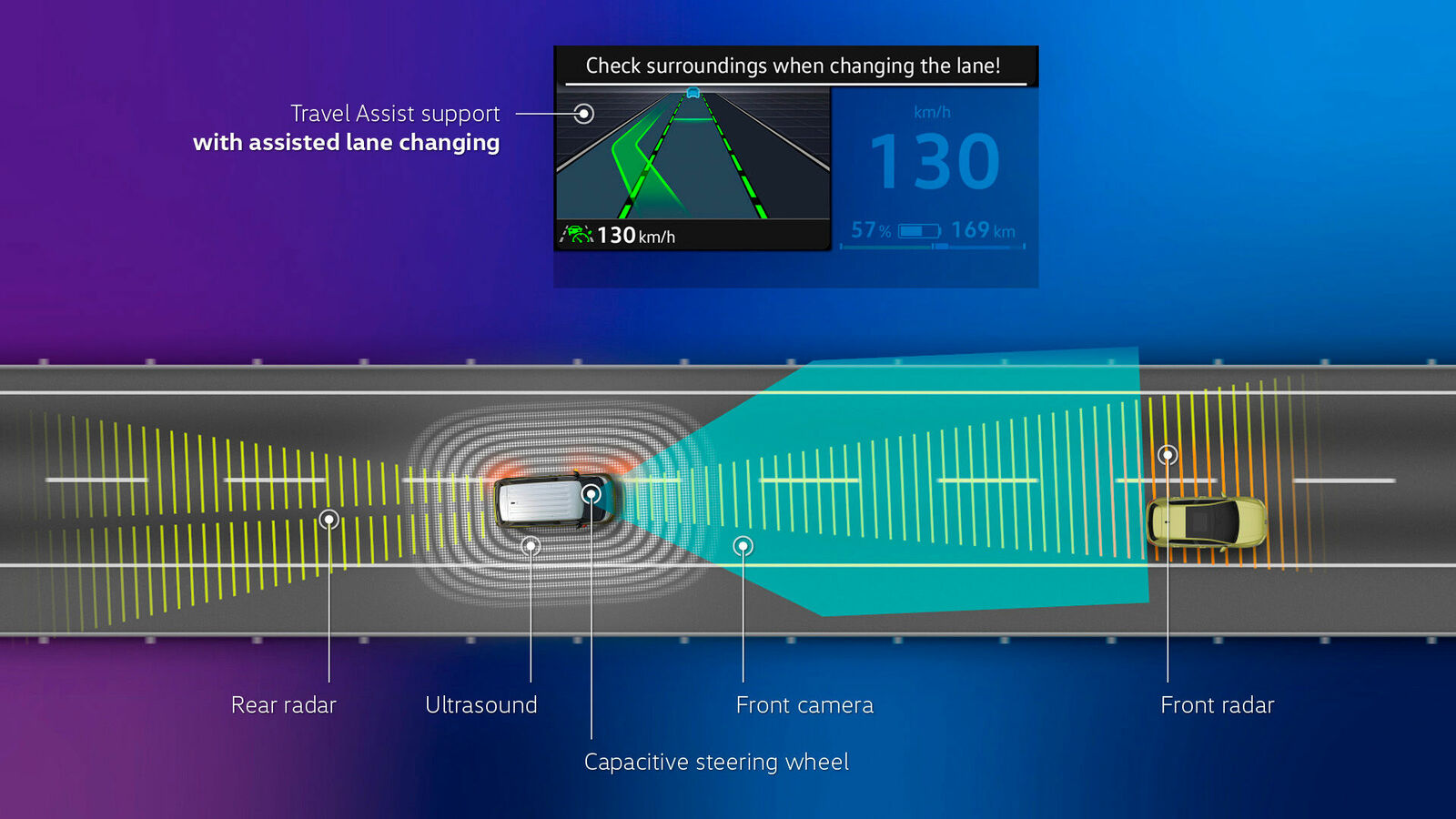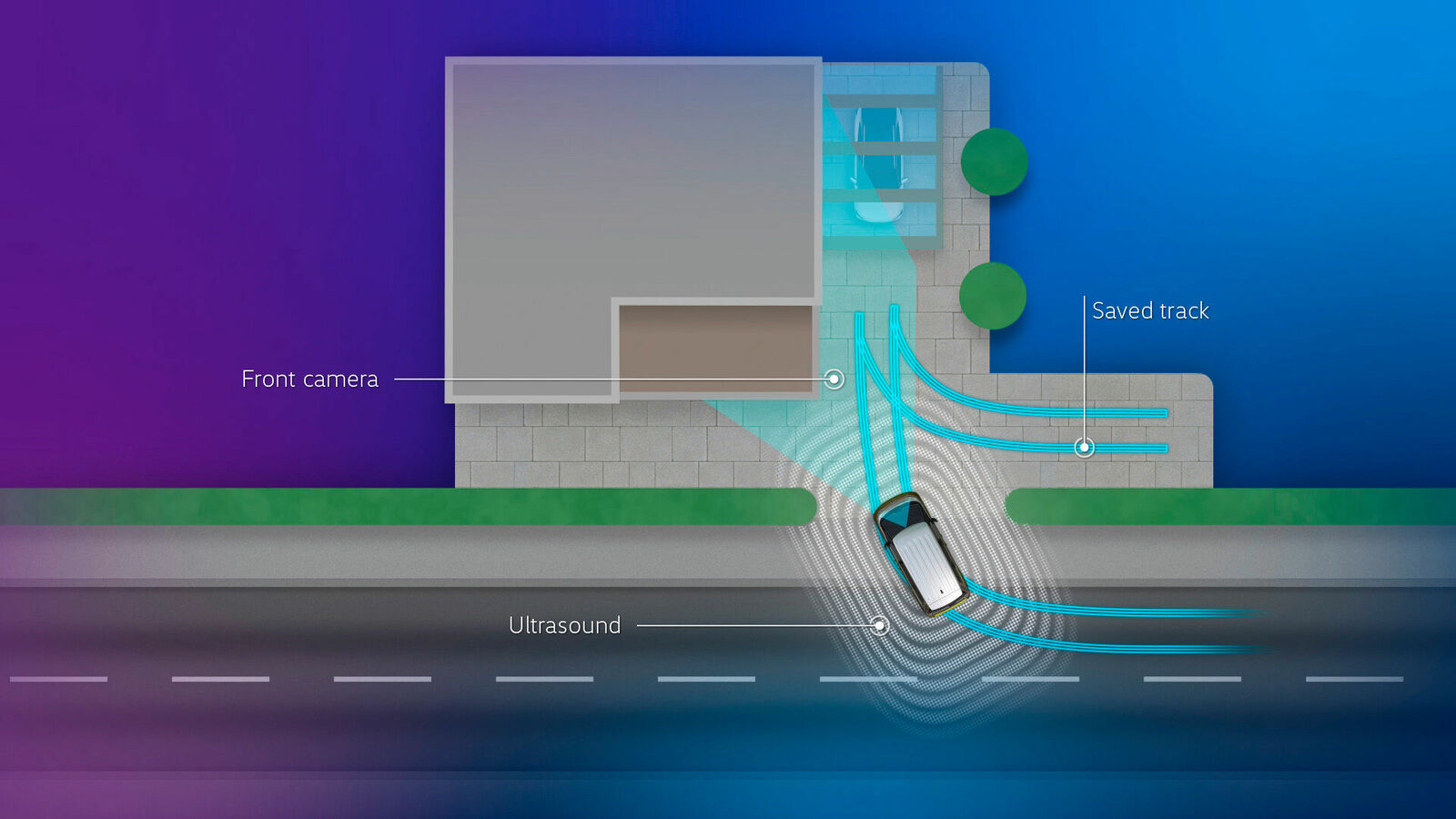The vehicle can perform assisted lane changes on the motorway if the turn signal lever is tapped briefly. It can use swarm data or also learn recurring parking manoeuvres: the Volkswagen ID. Buzz01 is being introduced with new intelligent assistance systems that can make driving even more convenient and also increase safety. This is in line with Volkswagen’s commitment to make the latest technologies accessible to a wide customer base early on.
Volkswagen is using fully integrated latest-generation assistance systems in the ID. Buzz. The optionally available Travel Assist with swarm data3/4 and Park Assist Plus with memory function3 are perfect examples of this. These systems can also be optionally ordered for all other newly produced ID. models from the ID.303 and ID.4 up to the ID.5.
Travel Assist with swarm data3/4
The optional Travel Assist can keep the vehicle in lane, maintain a distance from the vehicle in front and also ensure that the vehicle keeps to a maximum speed set by the driver. Among other things, it uses the adaptive lane guidance system for this. This system actively keeps the vehicle in the middle of its lane. Travel Assist adapts itself to the driver’s driving style and can also keep the vehicle further left or right in the lane instead of exactly in the centre. Travel Assist also comes with predictive cruise control and a cornering assist function. Here, the vehicle speed can be adapted to valid speed limits and the course of the road (bends, roundabouts, etc.).
New Travel Assist features. If anonymised swarm data is available from other Volkswagen models, Travel Assist with swarm data can use just one identified road lane marking to keep the vehicle in lane. In this case, the assistance system is also available on country roads without a central lane marking, for example. The availability of Travel Assist is increased even further by swarm data, improving comfort and the level of assistance for the customer.

Swarm data from the fleet. With the use of swarm data, Volkswagen is taking the next step towards highly automated driving. The anonymised swarm data is generated by several hundred thousand Volkswagen Group vehicles. For this, the vehicle fleet also collects map material with specific features from the area surrounding the vehicle – such as marker lines and road signs – and automatically transmits this information to the cloud. From there, individually adapted data is sent to the participating Volkswagen models that are currently driving along the relevant road sections. The database is growing all the time thanks to the large number of participating vehicles.
Assisted lane changes from 90 km/h. When driving on motorways at speeds above 90 km/h, Travel Assist with swarm data can actively support lane changes if this is desired by the driver. When activated, the lane change process can be started and executed by tapping the turn signal. For the operation to be completed, the sensors must not have detected any objects around the vehicle and the capacitive steering wheel must be able to detect the driver’s hands. The ID. Buzz then automatically steers itself into the desired lane. The driver is able to intervene at any time and take over the manoeuvre.
Park Assist Plus with memory function3 allows the vehicle to drive independently into parking spaces
The second optional assistance system in the ID. Buzz is Park Assist Plus with memory function. This innovative driver assistance system can be used to teach the vehicle up to five individual parking manoeuvres. The memory function remembers parking procedures at speeds below 40 km/h and covering distances of up to 50 metres. This allows the vehicle to be parked in a carport or garage, for example. The driver only has to park the vehicle once and save the parking procedure. The ID. Buzz can then repeat the learned parking manoeuvre on its own. All the driver has to do then is monitor the situation.

After activation in the Parking menu, Park Assist Plus3 can also search for a parking space and carry out the parking manoeuvre. When driving past parking spaces, the intelligent assistance system detects suitable parallel parking spaces at speeds of up to 40 km/h and parking bays at up to 20 km/h. The driver then only needs to stop at the selected parking space, press the brake and activate and monitor the parking procedure. The assistance system parks the ID. Buzz with the aid of the sensors that monitor the surroundings – it steers, accelerates, brakes and changes gear. It can also continue parking manoeuvres that have been started by the driver and complete them if possible. The system also provides support when driving out of parallel parking spaces again.
Wide range of driver assistance systems
In addition to Travel Assist with swarm data and Park Assist Plus with memory function, the ID. Buzz also features other driver assistance systems that can help to increase driving safety. The following assistance systems are on board as standard: swerve support3, oncoming vehicle braking when turning3, Driver Alert System3, Autonomous Emergency Braking3 Front Assist with Pedestrian and Cyclist Monitorin3, lane keeping system Lane Assist 3, Dynamic Road Sign Display3, and the Car2X traffic hazard alert function3, where vehicles inform each other of critical situations. Other assist systems are also optionally available. These are Adaptive Cruise Control ACC stop & go3 (see Travel Assist for included functions), anti-theft alarm system with interior monitoring, Keyless Advanced locking and starting system, Park Assist Plus3, Area View3 and the lane change system Side Assist3.
3The driver assistance function can only be used within the limits of the system. The driver must be prepared at all times to override the assistance system. These systems do not absolve drivers of their responsibility to drive with due care and attention. The operation can be disabled at any time.
4Travel Assist with swarm data: the system can be used up to the vehicle’s top speed. Only in combination with a navigation system. Only in combination with an active We Connect licence. The online components of Travel Assist with swarm data can only be used when there is mobile network coverage and if the relevant privacy settings have been activated. The online component can be disabled at any time in the We Connect ID. app. The online component of Travel Assist is available in the following countries: Austria, Belgium, Bulgaria, Croatia, Cyprus, Czech Republic, Denmark, Estonia, Finland, France, Germany, Great Britain and Northern Ireland, Greece, Hungary, Ireland, Italy, Latvia, Lithuania, Luxembourg, Malta, Netherlands, Norway, Poland, Portugal, Romania, Slovakia, Slovenia, Spain, Sweden, Switzerland. To activate the online functions, you will need a Volkswagen ID user account, and must log into We Connect with your username and password. A separate We Connect contract must also be concluded with Volkswagen AG online. Following delivery of the vehicle, you have 90 days in which to activate the online component of Travel Assist with swarm data. Once this period has expired, the initial 3-year usage period (free of charge) for the online component of Travel Assist with swarm data will start. An integrated Internet connection enables the online component of Travel Assist with swarm data to be used. The related data charges incurred within Europe are borne by Volkswagen AG where network coverage is available. Depending on your mobile phone tariff, transferring data via the internet may incur additional charges (e.g. roaming charges), particularly if you are using it abroad. For the delivery of this service, certain personal data – such as location and IP address of the vehicle – has to be transferred. Further information about data processing is provided in the Privacy Policy for Travel Assist with swarm data. The availability of the individual services described in the packages can vary depending on the country. The services are available for the agreed contract term and may change or be discontinued during this contract term. Further details can be found at connect.volkswagen-we.com and from your Volkswagen dealership. Information on mobile tariffs is available from your mobile provider.
SOURCE: Volkswagen

